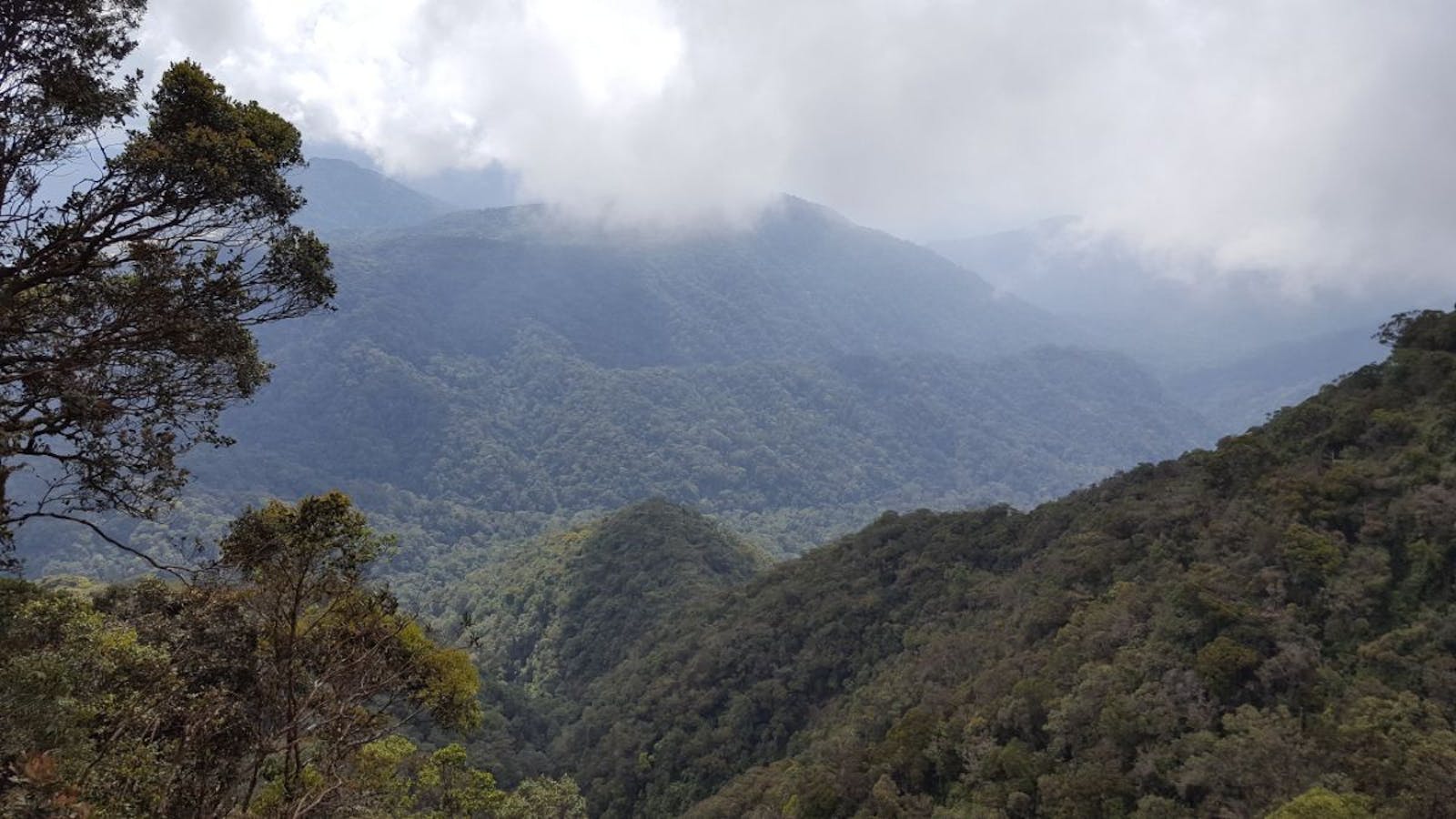Cameroon Highlands Forests
The ecoregion’s land area is provided in units of 1,000 hectares. The protection goal is the Global Safety Net (GSN1) area for the given ecoregion. The protection level indicates the percentage of the GSN goal that is currently protected on a scale of 0-10. N/A means data is not available at this time.
Bioregion: Mandara Mountain & North Congolian Forest-Savannas (AT16)
Realm: Afrotropics
Ecoregion Size (1000 ha):
3,813
Ecoregion ID:
2
Protection Goal:
47%
Protection Level:
1
States: Cameroon, Nigeria
Home to an endemic subspecies of the lowland gorilla—one of Africa’s most endangered primates—the Cameroon highland forests grow on an extinct range of volcanoes, where recently active history is shown by remnant craters, hot springs and other signs of volcanism. Other evidence of this region’s past are the fertile soils derived from volcanic rocks. The forests are of extremely high biological importance with many endemic species.
These highland forests cover the mountains of the border region between Nigeria and Cameroon, excluding Mount Cameroon. Most of the mountains are below 2,600 m in elevation. Included are the outliers northeast to the Mambila Plateau and northwest to the Obudu Plateau of Nigeria. Further northeast, the ecoregion continues along the western flank of the Adamawa Plateau to Tchabal Gangdaba.
Although located in tropical Africa, the ecoregion’s mean maximum temperatures are below 20°C due to the high altitude. At the southern extremity, closer to the coast, rainfall is around 4,000 mm per annum, declining inland to 1,800 mm or less. Vegetation consists of submontane forests between 900 and 1,800 m altitude, and above this a mixture of montane elements, including montane forests, montane grasslands, bamboo forests, and subalpine communities. The subalpine zone occurs above 2,800 m and is only found on Mount Oku which, at 3,011 m, is the highest point in this ecoregion.
.jpg)
The flagship species of the Cameroon Highlands Forests ecoregion is the Bamenda apalis. Image credit: Courtesy of Adv7440, iNaturalist
These mountains fall within the Afromontane archipelago-like regional center of endemism. Tree species diversity in these forests tends to be low but the diversity of non-woody plants is high. Some typical species are include Nuxia congesta, Podocarpus latifolius, Prunus africana, Rapanea melanophloeos, and Syzygium guineense. There is also a significant endemic flora in the grasslands, heathlands, moorlands and other non-forested habitats at higher elevations; for example, around the summit of Mount Oku.
The ecoregion contains remarkable levels of avian endemism, including the Bamenda apalis, Bangwa forest warbler, and the white-throated mountain-babbler. Exceptionally high levels of endemism are found among amphibians, with nearly 40 species that are strictly endemic. Mammal species found in this region include several groups of drill (a primate related to baboons and mandrills) in Bakossi, as well as healthy populations of Preuss’s red colobus and chimpanzee.
Montane forests above 1,800 m altitude formerly occurred over a much greater area of the Cameroon Highlands. Today they are reduced to small patches, which are under threat from agricultural encroachment and burning by pastoralists. This is one of the least formally-protected ecoregions in Africa, although local traditional rulers still exert considerable authority over land use and have protected many of the remaining forest areas.
Nlonako Mountain is a faunal reserve that provides protection from logging. The Gashaka Gumti National Park in Nigeria contains some montane forest, and some fragments remain at Obudu in the Okwangwo section of the Cross River National Park. Forest loss at Mount Oku/Ijim has been halted since 1986 by projects working with local chiefs and community members around the forest area. Large mammals are virtually extinct in Oku, however, and forest succession is impeded by grazing of goats. The remaining montane fragments are highly vulnerable to fires set by cattle grazers.
Forest cover has declined by more than 50% since the 1960s, through conversion to cultivation because of the relatively fertile soils derived from volcanic rock and the reliable rainfall in this area. This has also resulted in a high human population density. In parts of the Bamemda Highlands, for example, there are up to 300 people per km2.
Other major threats to the natural habitats include the unsustainable use of timber, fires from farmland, and collection of firewood and construction materials. The once common African cherry tree has suffered serious declines in the last two decades because of uncontrolled exploitation of its bark for pharmaceutical use. Additionally, hunting poses a serious threat to the remaining larger mammals.
The priority conservation actions for the next decade will be to: 1) develop Participatory Forest Management Plans for threatened forests; 2) support alternative livelihood opportunities for local communities dependent on the forests; and 3) establish more protected areas and increase their effectiveness in this ecoregion.
Citations
1. The Royal Society for the Protection of Birds. 2018. Participatory forest management in Taraba State, Nigeria. [Online]. [Accessed 11 January 2018]. Available from: https://www.rspb.org.uk/our-work/conservation/projects/participatory-forest-management-taraba-state-nigeria/
2. White, F. 1983. The vegetation of Africa, a descriptive memoir to accompany the UNESCO/AETFAT/UNSO. United Nations Educational, Scientific and Cultural Organisation. Paris: France.
3. Maisels, F.G., Cheek, M. and Wild, C. 2000. Rare plants on Mount Oku Summit, Cameroon. Oryx. 34(2), pp.136-140.




